As we saw in the case of Korey Stringer, one of the most important environmental factors that affect animals is temperature. And for many animal species, the control of temperature, called thermoregulation, is an essential component of homeostasis. Some of the important benefits to controlling body temperature include enhancing enzyme stability and efficiency (just a small change in temperature often significantly reduces the rate at which an enzyme catalyzes a reaction), giving organisms more independence in the timing of their daily activities, and resisting freezing.
In thermoregulation, the biggest distinction among animal species is in how they generate their body heat. Endotherms (sometimes described as “warm-
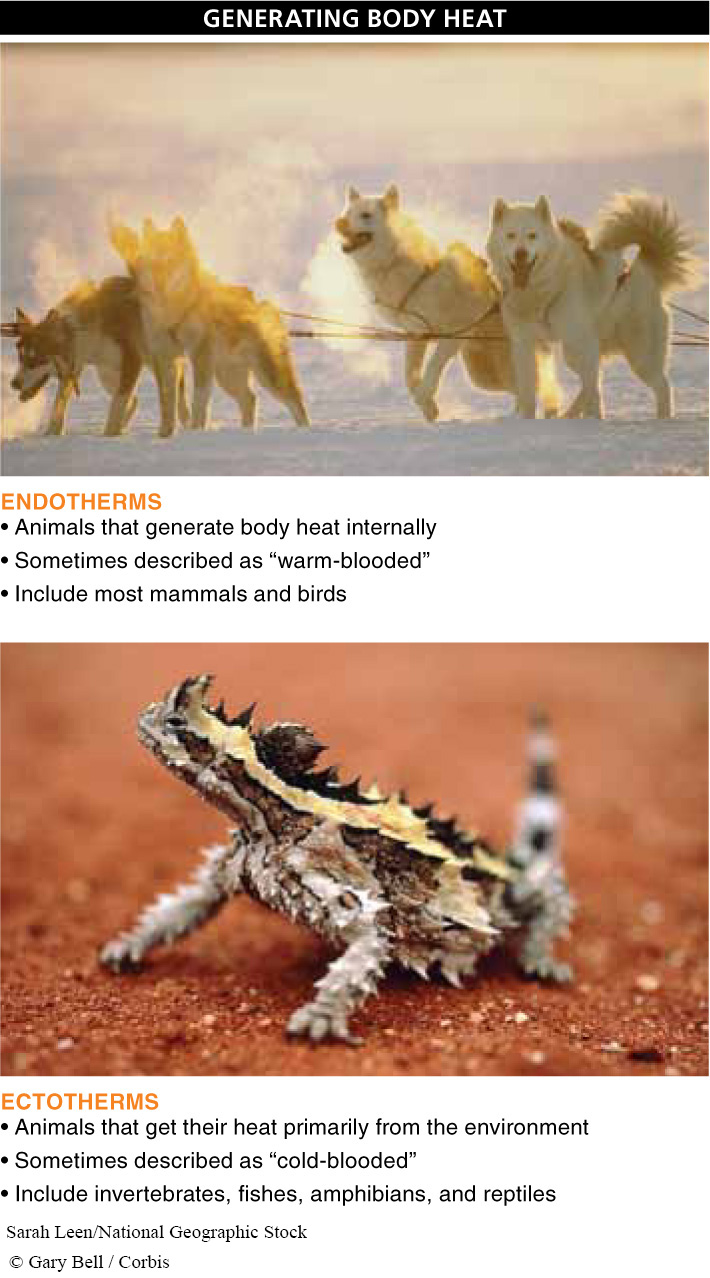
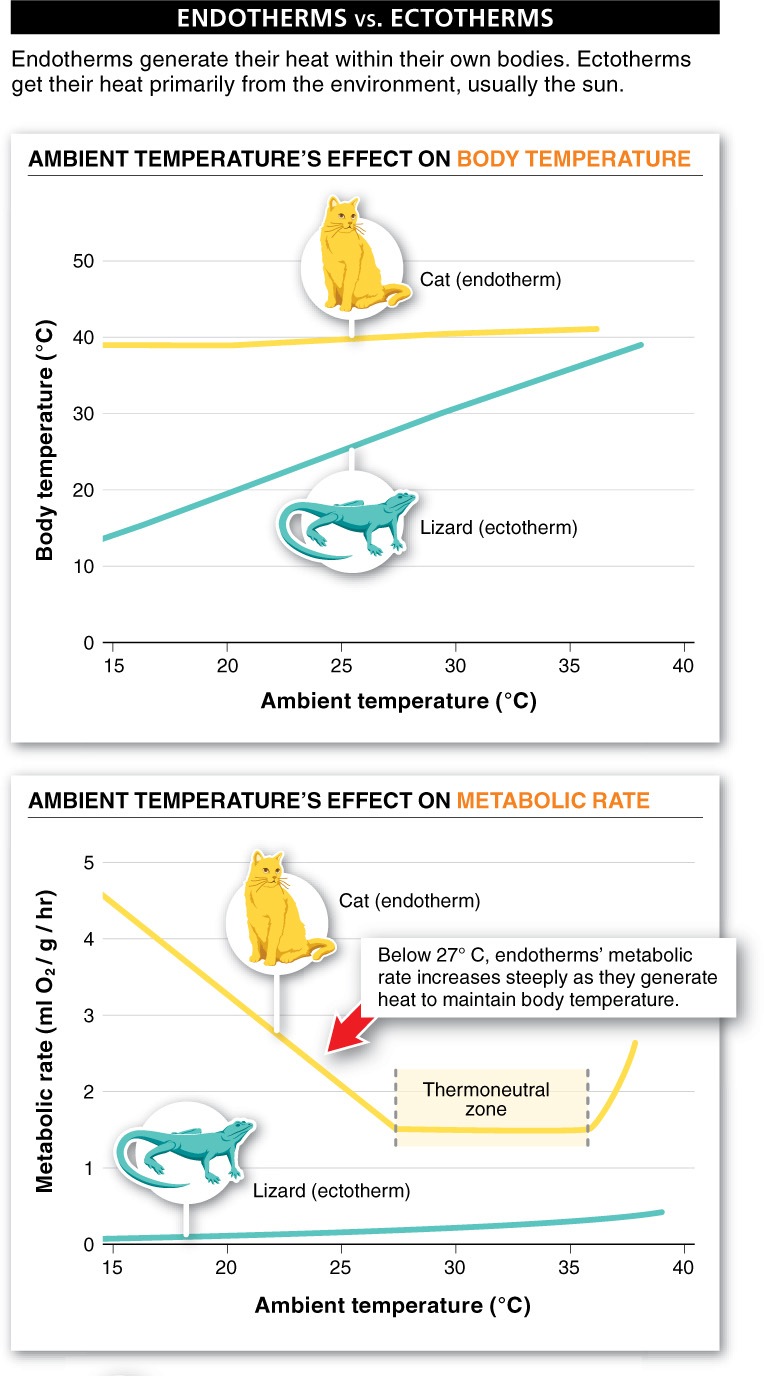
Each means of generating body heat has its costs and benefits. Between the temperatures of 27° and 36° C, for example, endotherms are able to maintain a constant internal body temperature without any energy expenditure, using passive methods of regulation such as heat loss through the skin. Below this temperature zone (called the thermoneutral zone), however, their metabolic rate increases significantly as they use active heating to maintain their body temperature. By contrast, the metabolic rate of ectotherms increases continuously across this range of temperatures (27° to 36° C), and in temperatures below 27° C, their metabolic rate decreases as they let their body temperature drop along with the ambient temperature (FIGURE 20-19).
810
Why do some cold-
As noted earlier, endotherms and ectotherms are often distinguished as “warm-
These observations highlight another important aspect of thermoregulation. Some organisms (such as humans) are homeotherms, meaning that they maintain a relatively constant body temperature. Other organisms (such as lizards and the hibernating mammals) are heterotherms, and their body temperature, at times, fluctuates as the environmental temperature changes (FIGURE 20-20). As a consequence, animals are most accurately categorized by describing both their source of heat (internal or external) and the degree to which they maintain a constant temperature or have a temperature that fluctuates.
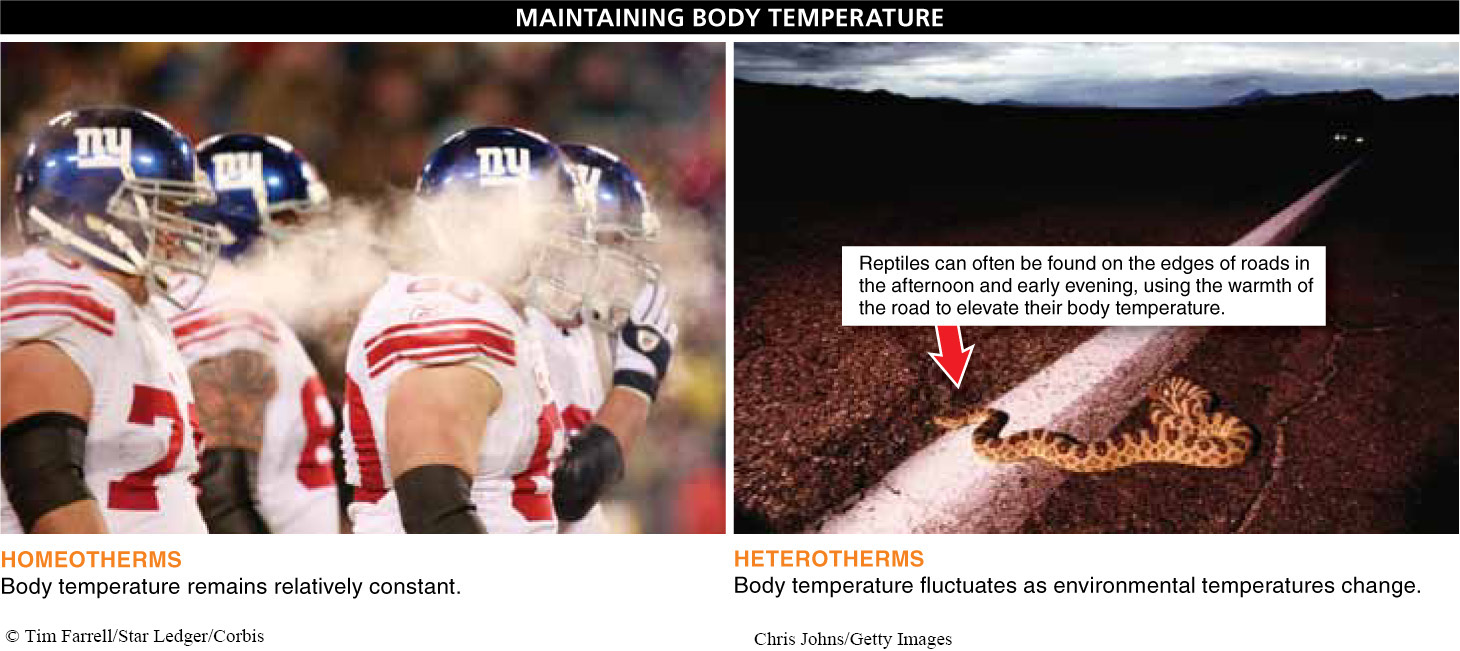
811
Whether or not an animal generates its own heat and maintains a constant body temperature, all animals exchange heat with the environment. Ultimately, an organism’s temperature is a function of the heat produced by its body in conjunction with the heat transferred from the environment to its body or from its body to the environment. This heat exchange can occur in four ways.
- 1. Conduction is the transfer of heat that occurs when two objects at different temperatures come in contact. Holding an ice cube or sitting on a hot car seat dramatically reveals conduction in action.
- 2. Convection is the transfer of heat from an object to a medium such as water or air as it passes next to the object. This is particularly noticeable to us when a cold breeze blows.
- 3. Radiation is the transfer of heat, without direct contact, from a warmer object to a colder object. You are experiencing radiant heat when you feel the warmth of the sun on your face or the heat from a fireplace on your feet.
- 4. Evaporation is the loss of heat that occurs as a liquid substance, such as liquid water, turns to a gas. When you sweat and the sweat evaporates, it cools you off.
We’ll find further examples of each of these mechanisms as we look at four of the methods—
Numerous physical features have evolved in organisms that influence their body temperature. These include body size, surface area, and levels of insulation. The thick, lipid-
An organism can also use behavioral strategies to regulate its body temperature. Most lizards, for example, bask in the morning sun, increasing their body temperature. Later, when the day is at its hottest, they may retreat to a burrow to reduce their body temperature. Many large mammals that cannot get to shade orient their bodies to minimize the angle at which the sunlight strikes them. The African ground squirrel even shades itself with its tail as it forages.
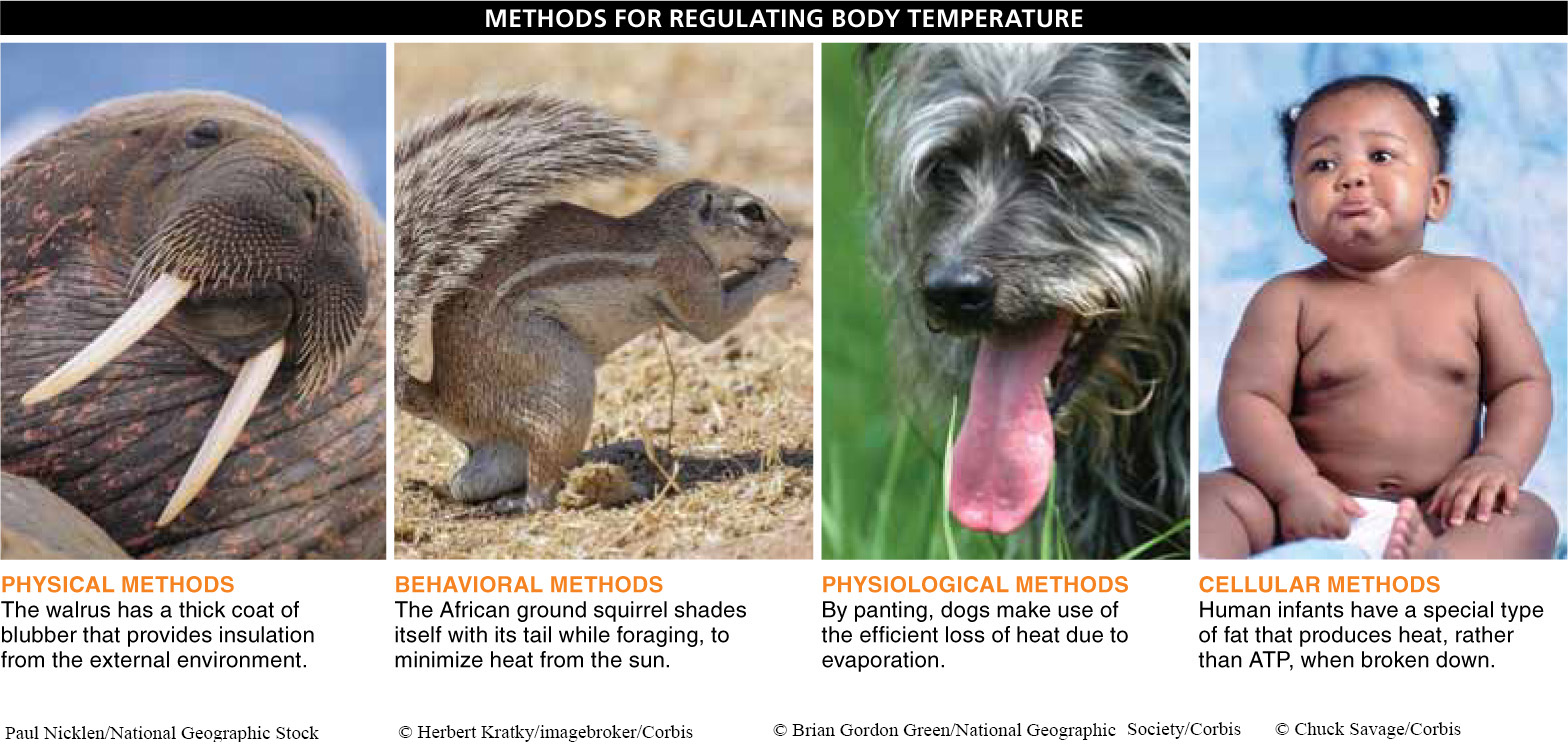
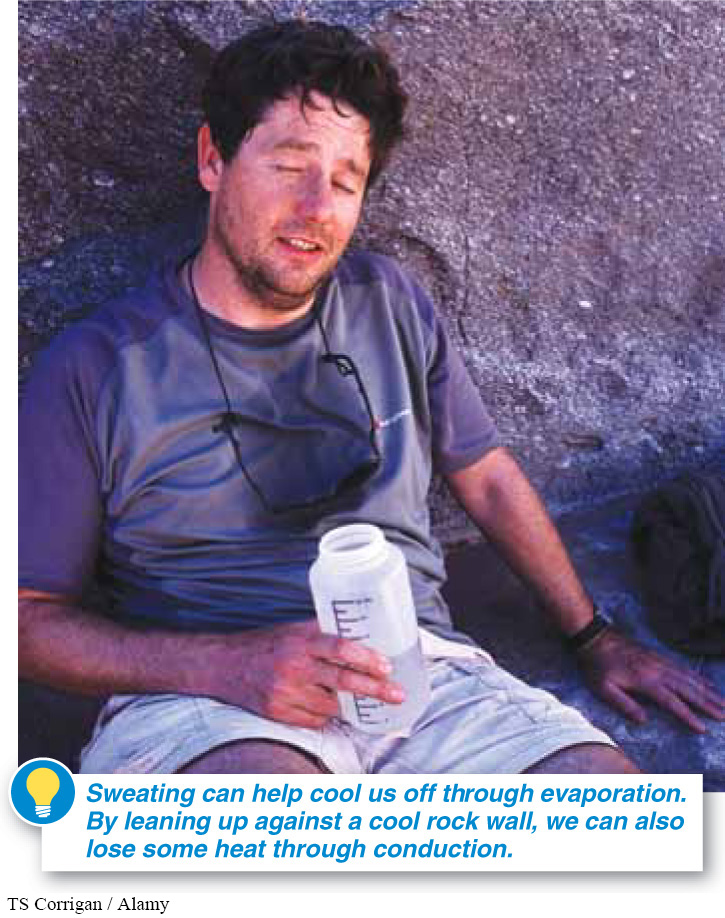
Animals also employ many physiological methods of thermoregulation. One specific example of this occurs as cells maintain concentration gradients of various ions, such as potassium (K+) and sodium (Na+). Many cell membranes are somewhat permeable to K+ and Na+ ions. The ions “leak” across the membrane, requiring active transport to restore and maintain the concentration gradients necessary for some cellular processes. Because the reactions involved in active transport are not perfectly efficient in their use of energy, some energy is released as heat with each reaction.
812
This heat can help maintain an organism’s body temperature. Cells may use up to 40% of their available energy in maintaining Na+ and K+ ion concentration gradients through the process of active transport. Interestingly, cell membranes in endotherms, such as humans, are leakier than cell membranes in ectotherms, such as fishes, suggesting that such “leakiness” is an adaptation that helps endotherms generate heat internally. Heat generation is also the likely reason endotherms have, on average, three to four times as many mitochondria per cell as ectotherms, because mitochondria are the sites of greatest heat generation.
Another physiological method by which animals—
Why does “baby fat,” unlike regular fat, act like a built-
One cellular method of temperature regulation is particularly important to human babies. It takes place in a special type of connective tissue called “brown fat.” Unlike the cells of “white fat,” or adipose tissue (most of the fat in adults’ bodies), which have few mitochondria, the cells of brown fat have a high density of mitochondria along with the stored fat. When brown fat cells oxidize their fat, however, they don’t generate ATP. Instead, a special protein causes protons to leak directly across the mitochondrial membrane, rather than passing through the enzyme that synthesizes ATP (see Section 4-
813
TAKE-HOME MESSAGE 20.10
The control of body temperature, called thermoregulation, is an important component of homeostasis. Body temperature is a function of internal heat production and heat transfer between an organism and its environment. Heat transfer to and from the environment is regulated physically, behaviorally, physiologically, and at the cellular level.
An insulating layer of fat, fur, or feathers can serve as a physical method of regulating body temperature. A cellular method of temperature regulation takes place in the brown fat of human babies, which serves to produce heat instead of ATP when food molecules are oxidized. Give one example each of a behavioral and a physiological method by which a homeotherm maintains a constant body temperature.
Behavioral methods of temperature regulation include basking in the sun or moving to the shade at different times of the day. Panting, sweating, and altering blood flow to the skin are all physiological methods of regulating body temperature.